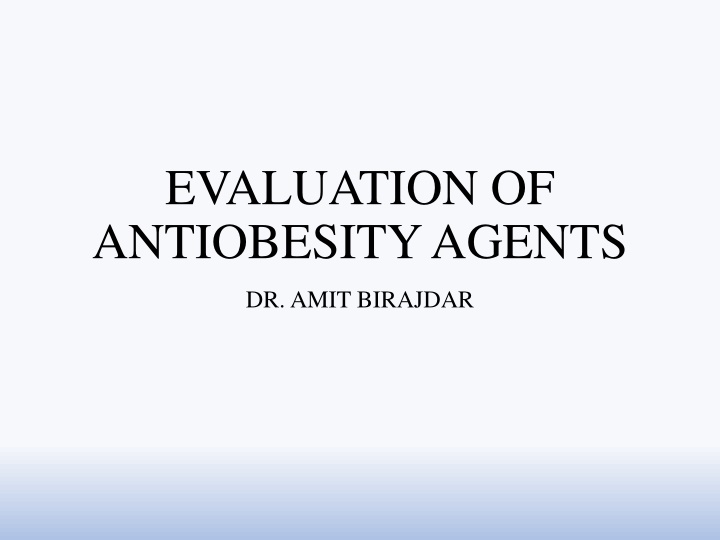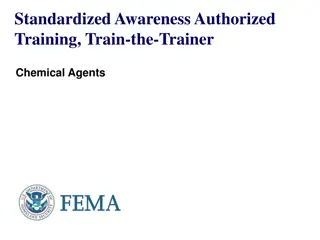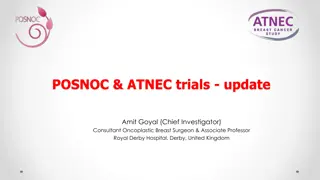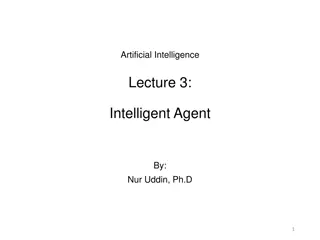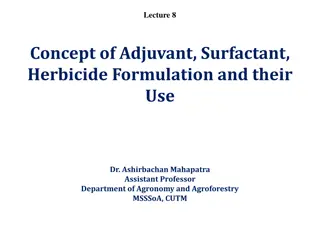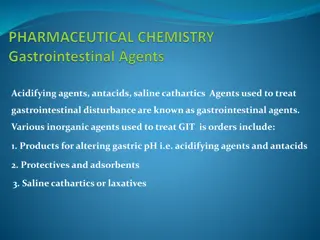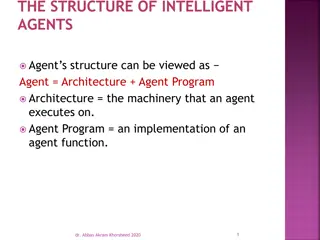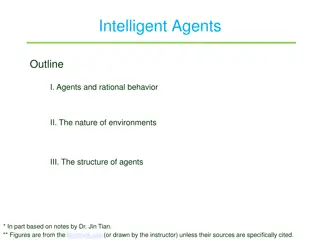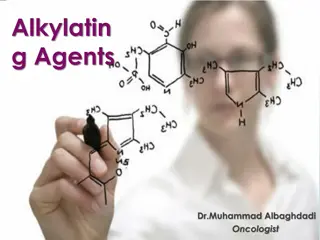Evaluation of Antiobesity Agents by Dr. Amit Birajdar
Obesity, recognized as a disease since 2013, affects billions globally. This presentation explores the multifactorial causes, pathophysiology, measurement methods of obesity, antiobesity drugs, and treatment options such as surgical and medical management. The focus is on evaluating pre-clinical and clinical aspects to combat this prevalent health concern.
Download Presentation

Please find below an Image/Link to download the presentation.
The content on the website is provided AS IS for your information and personal use only. It may not be sold, licensed, or shared on other websites without obtaining consent from the author.If you encounter any issues during the download, it is possible that the publisher has removed the file from their server.
You are allowed to download the files provided on this website for personal or commercial use, subject to the condition that they are used lawfully. All files are the property of their respective owners.
The content on the website is provided AS IS for your information and personal use only. It may not be sold, licensed, or shared on other websites without obtaining consent from the author.
E N D
Presentation Transcript
EVALUATION OF ANTIOBESITY AGENTS DR. AMIT BIRAJDAR
Outline of Presentation Introduction Existing therapy Evaluation 1. Pre - Clinical (In vitro & In vivo) 2. Clinical Conclusion 15-04-2025 2
OBESITY Definition :- State of excess adipose tissue mass that may impair health. BMI >25 is overweight and >30 is obese Bariatric - Branch of medicine that deals with the causes, prevention & treatment of obesity. 15-04-2025 3
Introduction Since June 2013, Obesity is recognized as disease by American Medical Association. In 2014, Prevalance doubled compare to 1980 >1.9 billion adult overweight (600 million obese) 39% of adults - overweight 13% of adults - obese 42 million child < 5 - Overweight / obese in 2013. In 2008 India, 1.3% males & 2.4% females (adult) obese. 15-04-2025 4
Obesity is multifactorial disease :- High fatty diet Sedentary lifestyle Smoking Lack of exercise Genetic & some psychiatric conditions Medication (Atypical anti-psychotic) & Obesity related complication 15-04-2025 5
PATHOHYSIOLOGY 6 15-04-2025
Measure of excess body fat & composition Body mass index (BMI) Waist & Hip circumference Waist Hip ratio Skin fold thickness Densitometry (underwater weighing) CT scan and MRI 15-04-2025 7
Antiobesity Drugs Drug Status(FDA) Orlistat Marketed Topiramate/Phentermine Approved 2012 Lorcaserin Approved 2012 15-04-2025 8
OBESITY TREATMENT SURGICAL MANAGEMENT MEDICAL MANAGEMENT BARIATRIC SURGERY SLEEVE GASTRECTOMY GASTRIC BYPASS LAPROSCOPIC BAND ORLISTAT 15-04-2025 9
15-04-2025 10
Need for New Drug Obesity is disease with major complication. Surgical and medical treatment is not up to mark Only three FDA approved anti obesity drugs for long term management. They have very modest effect on reduction of weight after used for 1 year. Bariatric surgery is still better Due to poor track record of approved drugs in this therapeutic indication - Discovery of safer compound delivering superior efficacy. 15-04-2025 11
Evaluation of anti- obesity drug Preclinical Clinical In Vitro In Vivo Phase 1,2,3,4 15-04-2025 12
In Vivo Model 15-04-2025 13
Ideal Animal (Rodent) Omnivores Complex taste & digestive system Identifying & consuming variety of different foods Neuro anatomically similar Brain areas play a role in control of food intake Different neurotransmitters and peptides produce similar effects on food Intake and energy homeostasis 15-04-2025 14
Disadvatage:- Phylogenetically not closely related Female :- subcutaneous fat & oestrus cycle Male :- visceral fat Female sensitive to leptin inhibition Male sensitive to insulin Difference in physiology of rodent and human 15-04-2025 15
Purpose of animal model Excellent predictive validity translation from rodent to human easily. Assessment of intervention in shorter time. Allows investigation of patho-physiology and evaluation of potential strategies for treatment & prevention. Readily tested, biopsied & autopsied. Life span of rodent is low & easily breed. 15-04-2025 16
Method to induce experimental obesity A. Food induced obesity Acute model Chronic model B. Surgical model of obesity C. Chemical model of obesity 15-04-2025 17
Food induced obesity Male SD rat Special Diet at weaning till 6 months After 6 months ( 450g) animal, Group I : Ordinary rodent chow Group II: Chow + corn oil + condensed milk Total duration: 3 months Parameters:- 1. Body weight and food intake ( every 3 days) 2. Adipose tissue size and number ( Folch et al.) 3. Carcass composition, plasma lipids, hormone & glucose levels 15-04-2025 18
Acute models of food intake Lean Rat vs lean Mouse Re-feeding models vs freely-feeding Chronic models of food intake Obese rat vs obese Mouse Dietary induced vs genetic vs hypothalamic obesity 15-04-2025 19
Advantage of Acute Model Typically undertaken in lean animal. Investigation of acute effect of candidate drugs on the food intake. Useful in screening of candidate compounds rapidly & obtain information regard to the potency, efficacy, duration of action. Side effect profile of compound in vivo. Selection of compound for chronic testing. 15-04-2025 20
Disadvantage of Acute Model Not in female animal. Not physiological method of model stress induction. Insensitive to delayed action of drug & delayed acting drug. Not relevant to all mechanisms of drug action. Absence of complex psychological factors. Different pharmacological profile inspite of having similar homology 15-04-2025 21
Advantage of Chronic Model Investigating the chronic effectof candidate drugs on the food intake. Investigate multiple antiobesity mechanism of drug. Drugs with delayed mechanism of action can be tested. Find out candidate molecules to be tested in human. Maintained reduction of body weight 15-04-2025 22
Disadvantage of Chronic Model Non analogous environmental situation :- Individually housed (Restricts Social Interaction) Small cages (Restrict Physical Activity) Housed at lower temp. than thermo neutral Food is readily available ,Not happen in human Proven fatal side effects of drug not reported Animals need to be sacrificed. Psychological factor 15-04-2025 23
Surgical Model of Obesity Lesion of VMH -Sympathetic (decrease) & Parasympathetic (increase) nervous systems -Destruction of POMC neurons -Elevated insulin and reduced glucagon Lesion of PVN Lesion of ARC 15-04-2025 24
Ovariectomy Increase in body weight due to increase in eating Tonic dis-inhibition due to the lack of estradiol No estrus cycle effect on diet lack of effect of estradiol on meal controllers such as CCK, GLP-1, glucagon and others BUT, Lean body mass increased & subcutaneous fat. 15-04-2025 25
Chemical model of obesity Gold Thioglucose Induced Obesity Intra peritoneal or Intramuscular injection - destruction of hypothalamic & extra-hypothalamic areas of brain. At 6 week, single intra peritoneal injection of 30 40 mg/kg gold thioglucose. Food intake - 2 week & Body weight - 3 month used for peripherally acting anti-obesity drug. 15-04-2025 26
Monosodium Glutamate Induced Obesity Male Charles River mice - immediately after birth with daily subcutaneous inj. of 2 g/kg monosodium- L-glutamate for 5 consecutive day. Food consumption and weight gain weekly. Ablation of brown adipose tissue In Mice , diphtheria toxin A in UCP-1 expressing cells; It leads to ablation of approximately 70% of BAT. 15-04-2025 27
Genetically Obese Rodent Visible with several weeks of birth & put on weight and become several times heavier than their lean part (50% by fat) Monogenic but rare in human Polygenic nature of obesity Mouse is the most common genetic model 15-04-2025 28
Genetically Obese Rodent 15-04-2025 29
15-04-2025 30
15-04-2025 31
15-04-2025 32
15-04-2025 33
Assays of anti-obesity activity A. Anorectic activity Food consumption in rats B. Metabolic activity GDP-binding in brown adipose tissue Uncoupling protein & GLUT4 in brown adipose Resting metabolic rate 3-adrenoceptor 15-04-2025 34
Food consumption in rats TYPE :- 1. Acute experiments -Food intake 2. Semi chronic experiments - Weight gain Exclude errors due to palatability Procedure :- Individual food intakes in grams at specified time. Mazindol, 3 m/kg i.p. or 10 mg/kg p.o. - standard. Treatment for 7 days. Drug affecting 5HT and NE are tested. 15-04-2025 35
Modifications:- Frequency, amount & duration of feed Stimulation for eating by food deprived tech. Automated feeding monitors Amount of food Hoarded 15-04-2025 36
GDP-binding in brown adipose tissue Major site of non-shivering thermogenesis The binding of the nucleotide GDP to Brown Adipose Tissue Membrane Protein, Uncoupling Protein or Thermogenin Indicator thermogenesis GDP binding is assessed from 3H radioactivity 15-04-2025 37
Uncoupling protein and GLUT4 in brown adipose tissue Male fatty (OLETF fatty) rats age of 10 weeks are given subcutaneous inj. of test drug or solvent once daily. After 14 week treatment, brown & white adipose tissue removed. Uncoupling protein - family of inner mitochondrial membrane transporters 1. m-RNA (Northern blot) analysis 2. Protein (Western blot) analysis 15-04-2025 38
Modification:- Radioimmunoassay Inj. NPY in hypothalamic Paraventricular nucleus UCP 1 - brown adipose tissue UCP2 - white adipose tissue UCP3 - muscle of SD rat Glucose utilization & increase of UCP1,3 after 3- adrenoreceptor agonist OR sibutramine 15-04-2025 39
Resting metabolic rate Measured by closed-circuit metabolic system Chamber :- 4.5 liter External loop containing canisters of desiccant and CO2 absorbent Pressure sensor Food cups &Water-tray placed at door A steel funnel shaped - urine collector After a stable baseline (30 min) , Drugs are administered and resting metabolic rate is measured for 1 hr at 22 C. 15-04-2025 40
3-Adrenoceptor 3-adrenoreceptor agonists - weight loss Mechanism:- 1. Increased thermogenesis 2. Increased lipolysis 3. Suppression of leptin gene expression & serum leptin Without a decrease in food intake Parameter: 1. Luciferase activity by assay kit & luminometer 2. RT-PCR 15-04-2025 41
Behavioural Model Behavioural satiety sequence model -Increased or decreased motor activity -Induction of motor behaviour Drug-induced malaise and aversion model -Decrease food intake coz of GI malaise -Pica - Persistent eating of inert sub.in rodent -Kaolin or China clay used to measure 15-04-2025 42
In Vitro Model 15-04-2025 43
Assays of obesity regulating peptide hormones A. Determination of leptin mRNA in adipose tissue Determination of plasma leptin B. Receptor assay of neuropeptide Y C. Receptor assay of orexin Radioimmunoassay for orexin D. Receptor assay of galanin E. Adipsin expression in mice 15-04-2025 44
Determination of leptin mRNA level in adipose tissue Northern blot analysis Leptin mRNA levels in - Primary cultured Liver -Intra-capsular brown adipose tissue -Epididymal white adipose tissue Quantitative analysis -Competitive RT-PCR -Capillary electrophoresis laser-induced fluorescence detection. 15-04-2025 45
Determination of plasma leptin Method of determination:- 1. Radioimmunoassay using a rat-specific antibody 2. Double-antibody radioimmunoassay kit based on a mouse standard 3. Immuno-precipitation assay 15-04-2025 46
Receptor assay of neuropeptide Y Radiolabelled I 125-labeled peptide Bioassays used characterization & classification of NPY receptor. 1. Y1 receptor- Rat kidney, Rabbit saphenous vein 2. Y2 receptor-Rat vas deferens & colon, Dog saphenous vein 3. Y4 receptor-Rat colon 4. Y5 receptor-Rabbit ileum 15-04-2025 47
Orexin Assay Orexin A & B bind both to OX1 & OX2 but Orexin B - low affinity to OX1. TYPE 1. Cell-bound radioactivity is determined by a - counter 2. Radioimmunoassay 15-04-2025 48
Receptor assay of galanin Radioligand 125 I-galanin Adipsin expression in mice Protein & m RNA level Modification:- 1.Tissue-specific transcription factor 2.Concentrations in blood & Rate of adipsin secretion by adipose tissue in human using a two- monoclonal sandwich ELISA assay. 15-04-2025 49
In Vitro Model Advantages: 1. A large number of compounds can evaluated in a short period of time 2. Limited amount of material required 3. Less number of animals required Disadvantages: 1. Limit discovery of mechanically novel substance 2. Complicated procedures 3. Require technical expertise 4. Costly 15-04-2025 50
